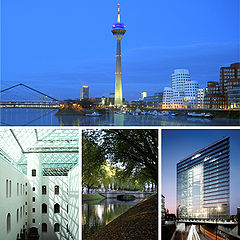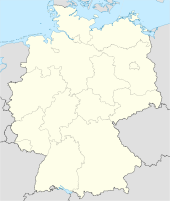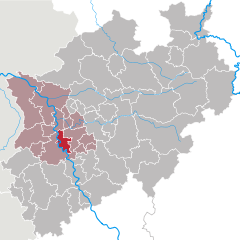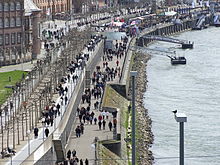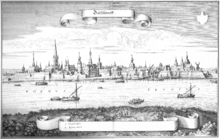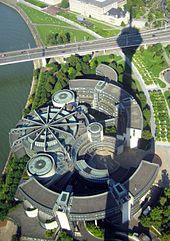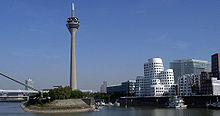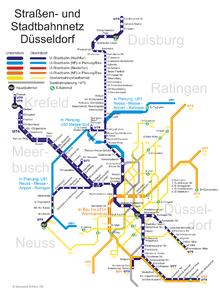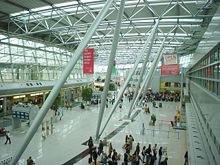- Düsseldorf
-
The title of this article contains the character ü. Where it is unavailable or not desired, the name may be represented as Duesseldorf.
Düsseldorf Top: Düsseldorf-Hafen
Bottom row from left: Ständehaus of Kunstsammlung Nordrhein-Westfalen, Königsallee and Stadttor

Coordinates 51°14′N 6°47′E / 51.23333°N 6.78333°ECoordinates: 51°14′N 6°47′E / 51.23333°N 6.78333°E Administration Country Germany State North Rhine-Westphalia Admin. region Düsseldorf District Urban district City subdivisions 10 districts, 49 boroughs Lord Mayor Dirk Elbers (CDU) Governing parties CDU / FDP Basic statistics Area 217 km2 (84 sq mi) Elevation 38 m (125 ft) Population 588,735 (31 December 2010)[1] - Density 2,713 /km2 (7,027 /sq mi) - Urban 1,220,000 - Metro 7,295,000 (Rhein-Ruhr) Other information Time zone CET/CEST (UTC+1/+2) Licence plate D Postal codes 40001-40629 Area code 0211 Website www.Duesseldorf.de Düsseldorf [ˈdʏsl̩dɔɐf] (
 listen) is the capital city of the German state of North Rhine-Westphalia and centre of the Rhine-Ruhr metropolitan region.
listen) is the capital city of the German state of North Rhine-Westphalia and centre of the Rhine-Ruhr metropolitan region.Düsseldorf is an important international business and financial centre and renowned for its fashion and trade fairs.[2][3][4] Located centrally within the European Megalopolis, the city is headquarter to five Fortune Global 500 and several DAX companies. Messe Düsseldorf organizes nearly one fifth of all world‘s premier trade shows.[5]
Culturally, Düsseldorf is known for its academy of fine arts (Kunstakademie Düsseldorf, e.g. Joseph Beuys, Emanuel Leutze, August Macke, Gerhard Richter, Sigmar Polke and Andreas Gursky), its influence on early electronic music (Kraftwerk) and its large Japanese community. As a city by the river Rhine, Düsseldorf is a stronghold for Rhenish Carnival celebrations. Every year in July more than 4.5 million people visit the city's Largest Fair on the Rhine funfair.[6]
As the seventh most populous city in Germany by population within city limits and an urban population of 1.5 million,[7] Düsseldorf is one of the country's five global cities. The Mercer's 2009 Quality of Living survey of cities with the highest quality of life ranked Düsseldorf sixth worldwide and first in Germany.[8][9]
Contents
Geography
Physical geography
Düsseldorf lies at the centre of the Lower Rhine basin, where the delta of the River Düssel flows into the Rhine. The city lies on the east side of the Rhine, except District 4 (Oberkassel, Niederkassel, Heerdt and Lörick). Across the Rhine, the city of Neuss stands on the delta of the Erft river. Düsseldorf lies southwest of the Ruhr urban area, and in the middle of the Rhine-Ruhr metropolitan region.
Düsseldorf is built entirely on alluvium, mud, sand, clay and occasionally gravel. The highest point in Düsseldorf is the top of Sandberg in the far eastern part of the city (Hubbelrath borough) at 165 metres (541 ft). The lowest point is at the far northern end in Wittlaer borough where the Schwarzbach enters the Rhine, with an average elevation of 28 metres (92 ft).
Adjacent cities and districts
The following districts and cities border Düsseldorf (clockwise starting from the north): the City of Duisburg, the District of Mettmann (Ratingen, Mettmann, Erkrath, Hilden, Langenfeld, and Monheim), and the District of Neuss (Dormagen, Neuss, and Meerbusch).
Climate
Like the rest of the lower, Rhineland, Düsseldorf has mild winters and moderately warm summers, with an average yearly temperature of 10.5 °C (51 °F) and about 77 centimetres (30 in) of rainfall. The dominant wind direction is from the south or southeast with velocities in the range of 3 to 4 m/s (7–9 mph), with gusts of 3.5 −4.8 m/s (8–10.7 mph). The wind is calm (defined as being under 2 m/s or 4.5 mph) about 35% of the time, more frequently at night and in the winter.[10][11]
Climate data for Düsseldorf Month Jan Feb Mar Apr May Jun Jul Aug Sep Oct Nov Dec Year Average high °C (°F) 4
(39)5
(41)8
(46)12
(54)17
(63)20
(68)22
(72)22
(72)18
(64)14
(57)8
(46)5
(41)12.9
(55.3)Daily mean °C (°F) 2
(36)3
(37)5
(41)8
(46)13
(55)16
(61)17
(63)17
(63)14
(57)11
(52)6
(43)3
(37)9.6
(49.2)Average low °C (°F) 0
(32)0
(32)2
(36)5
(41)9
(48)12
(54)13
(55)13
(55)11
(52)8
(46)3
(37)1
(34)6.4
(43.6)Precipitation mm (inches) 81.3
(3.201)55.9
(2.201)76.2
(3)68.6
(2.701)73.7
(2.902)96.5
(3.799)88.9
(3.5)76.2
(3)73.7
(2.902)71.1
(2.799)83.8
(3.299)88.9
(3.5)934.8
(36.803)Source: weather.com[12] History
When the Roman Empire was strengthening its position throughout Europe, a few Germanic tribes clung in marshy territory off the eastern banks of the Rhine River.[13]
In the 7th and 8th centuries, the odd farming or fishing settlement could be found at the point where the small river Düssel flows into the Rhine. It was from such settlements that the city of Düsseldorf grew.
The first written mention of the town of Düsseldorf (then called Dusseldorp in the local Low Rhenish dialect) dates back to 1135. Under Emperor Friedrich Barbarossa the small town of Kaiserswerth to the north of Düsseldorf became a well fortified outpost, where soldiers kept a watchful eye on every movement on the Rhine. Kaiserswerth eventually became a suburb of Düsseldorf in 1929.
In 1186 Düsseldorf came under the rule of Berg. The dukes of Berg moved their seat to the town in 1386. 14 August 1288 is one of the most important dates in the history of Düsseldorf as it was on this day that the sovereign Count Adolf V of Berg granted the village on the banks of the Düssel the Town privileges.
Prior to that announcement, a bloody struggle for power had taken place between the Archbishop of Cologne and the count of Berg, culminating in the Battle of Worringen. The Archbishop of Cologne's forces were wiped out by the forces of the count of Berg who were supported by citizens and farmers of Cologne and Düsseldorf, paving the way for Düsseldorf's elevation to city status, which is commemorated today by a monument on the Burgplatz. In fact, the custom of turning cartwheels is credited to the children of Düsseldorf. There are variations of the origin[14] of the cartwheeling children, but the most famous is the story. Today the symbol (Der Radschläger[14]) represents the story and every year the Düsseldorfers celebrate by having a cartwheeling contest.
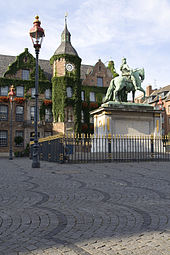 The historic townhall of Düsseldorf in the Altstadt.
The historic townhall of Düsseldorf in the Altstadt. The state parliament, seen from the top of the Rheinturm.
The state parliament, seen from the top of the Rheinturm.
After this battle the relationship between the two cities deteriorated, because they were commercial rivals. It is often said that there is a kind of hostility between the citizens of Cologne and Düsseldorf. Today, it finds its expression mainly in a humorous form (especially during the Rhineland Karneval) and in sports.
A market square sprang up on the banks of the Rhine and the square was protected by city walls on all four sides. In 1380, Düsseldorf was made regional capital of the Duchy of Berg. During the following centuries several famous landmarks were built, including the Collegiate Church of St. Lambertus. In 1609, the ducal line of the United Duchies of Jülich-Cleves-Berg died out, and after a virulent struggle over succession, Jülich and Berg fell to the Wittelsbach Counts of Palatinate-Neuburg, who made Düsseldorf their main domicile, even after they inherited the Electoral Palatinate, in 1685, becoming now Prince-electors as Electors Palatine.
Düsseldorf's growth was even more impressive under the leadership of Johann Wilhelm II (r. 1690-1716) in the 18th century, also known to his people as Jan Wellem. Greatly influenced by his wife Anna Maria Luisa de' Medici, the art lover designed a vast art gallery with a huge selection of paintings and sculptures that were housed in the Stadtschloss (city castle).
After the death of childless Jan Wellem, the flourishing royal capital fell on hard times again, especially after Elector Charles Theodore inherited Bavaria and moved the electoral court to Munich. With him he took the art collection, which became part of what is now the Alte Pinakothek in Munich. Destruction and poverty struck Düsseldorf after the Napoleonic Wars. Napoleon made Berg a Grand Duchy and Düsseldorf its capital. J. C. C. Devaranne, a leader of Solingen's resistance to Napoleon's conscription decrees, was executed here in 1813. After the defeat of Napoleon, the whole Rhineland including Berg was given to the Kingdom of Prussia in 1815. The parliament of the Rhine Province was established in Düsseldorf later.
By the mid-19th century, Düsseldorf enjoyed a revival thanks to the Industrial Revolution as the city boasted 100,000 inhabitants by 1882; the figure doubled in 1892.
In 1920, Düsseldorf became the centre for the General Strike. On 15 April 1920 45 delegates of the German Miners Union were murdered by the Freikorps.[15]
It was a target of strategic bombing during World War II, particularly during the RAF bombing campaign against the Ruhr industry in 1943 when over 700 bombers were used in a single night. Raids continued late into the war. As part of the campaign against German oil facilities, the RAF raid of February 20/21 1945 on the Rhenania Ossag refinery in the Reisholz district of Düsseldorf halted oil production there.
The Allied ground advance into Germany reached Düsseldorf in mid-April 1945. The US 97th Infantry Division easily captured the city 18 April 1945 in the absence of organized German resistance.[16]
In 1946 Düsseldorf was made capital of the new federal state of North Rhine-Westphalia. The city's reconstruction proceeded at a frantic pace and the economic transformation saw Düsseldorf grow into the wealthy city of trade, administration and service industries that it is today.
Demographics
17% of Düsseldorf's population are foreigners: a total of 101,481 people.[17] The largest ethnic minority groups are Turks, Greeks, and Italians.[18]
Düsseldorf has the third-largest Jewish community in Germany, with about 7,600 members: more than 1% of the city's population.
Düsseldorf and its surroundings have the third-largest Japanese community in Europe and the largest in Germany (about 11,000 people).[19][20]
Number of minorities (1st and 2nd generation) in Düsseldorf by country of origin per 31. December 2007[21]
Rank Ancestry Number 1  Turkey
Turkey30,000 2  Greece
Greece21,000 3  Italy
Italy13,000 4  Serbia
Serbia12,000 5  Poland
Poland12,000 6  Morocco
Morocco10,000 7  Japan
Japan10,000 8  Russia
Russia7,000 Government
Mayors
Main article: List of mayors of DüsseldorfDistricts
Main article: Districts of DüsseldorfDüsseldorf is currently (2007) divided into ten administrative districts. Each district (Bezirk) has its own elected district council (Bezirksvertretung) and its own district mayor (Bezirksvorsteher). The district councils are advisory only. Each district is further subdivided into boroughs. There are 49 boroughs in Düsseldorf.[22]
- District 1 (Stadtbezirk 1)
- Altstadt, Carlstadt, Derendorf, Golzheim, Pempelfort, Stadtmitte
- District 2 (Stadtbezirk 2)
- Düsseltal, Flingern-Nord, Flingern-Süd
- District 3 (Stadtbezirk 3)
- Bilk, Flehe, Friedrichstadt, Hafen, Hamm, Oberbilk, Unterbilk, Volmerswerth
- District 4 (Stadtbezirk 4)
- Heerdt, Lörick, Niederkassel, Oberkassel
- District 5 (Stadtbezirk 5)
- Angermund, Kaiserswerth, Kalkum, Lohausen, Stockum, Wittlaer
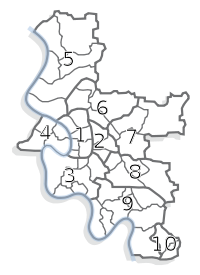
- District 6 (Stadtbezirk 6)
- Lichtenbroich, Mörsenbroich, Rath, Unterrath
- District 7 (Stadtbezirk 7)
- Gerresheim, Grafenberg, Hubbelrath, Ludenberg
- District 8 (Stadtbezirk 8)
- Eller, Lierenfeld, Unterbach, Vennhausen
- District 9 (Stadtbezirk 9)
- Benrath, Hassels, Himmelgeist, Holthausen, Itter, Reisholz, Urdenbach, Wersten
- District 10 (Stadtbezirk 10)
- Garath, Hellerhof
Economy
Düsseldorf is not only widely known as a centre of German advertising and fashion industries: in the last few years the city on the Rhine has become one of the top telecommunications centres in Germany. There are 18 internet service providers located in the capital of North-Rhine Westphalia. With two of the four big German providers of mobile frequencies, D2 Vodafone and E-Plus, Düsseldorf leads the German mobile phone market. There are also many foreign trading centres in Düsseldorf such as NTT, Ericsson, Sandvik, Nokia and GTS.[citation needed] Eurowings and formerly independent LTU International, are two airlines, with headquartered in the city.[23]
Many of the internet companies in Düsseldorf have their roots in the world of advertising: there are 400 advertising agencies in Düsseldorf, among them three of the largest in Germany: BBDO Group, Publicis Group and Grey Group. A number of affiliates of foreign agencies deserve mention as well, such as Ogilvy & Mather, Dentsu, Hakuhodo, Digital District and DDB.[citation needed] There are also about 200 publishing houses in Düsseldorf.[citation needed]
In Düsseldorf there are about 170 national and international financial institutions, and about 130 insurance agencies, and one of the biggest German stock exchanges. Several other major companies have their headquarters in the city: Peek & Cloppenburg (fashion), L'Oréal Germany (Cosmetics and Beauty); Henkel AG & Co. KGaA (Branded Consumer Goods and Industrial technologies); E.ON (energy); ThyssenKrupp (metallurgy); Metro (wholesale, retail); Ergo (insurance); LTU (air transport), Esprit Holdings (fashion, headquarters in Ratingen near Düsseldorf), Cognis (chemicals, headquarter in Monheim near Düsseldorf, but production mainly in Düsseldorf).[citation needed]
Daimler AG builds the Mercedes-Benz Sprinter and Volkswagen Crafter light commercial vehicles in Düsseldorf. Since the 1960s, there has been a strong relationship between the city and Japan. Many Japanese banks and corporations have their European headquarters in Düsseldorf - so many that Düsseldorf has the third largest Japanese community in Europe, after London and Paris.[19][20]
The "Kö", which stands for Königsallee ("King's Avenue"), is a popular shopping destination. Some of the most reputed jewellery shops, designer labels, and galleries have their stores here. The Kö has about the highest rents for shops and bureaus in Germany.[24] Messe Düsseldorf organizes several international congresses and trade fairs throughout the year, most notably boot Düsseldorf Boat Show, drupa Printing & Media and cdp Fashion Show.
Media
Important newspapers and journals such as Handelsblatt, Rheinische Post, Wirtschaftswoche, Deutsches Wirtschaftsblatt and VDI-Nachrichten are published in Düsseldorf. Almost all of these papers are available online on the Internet. Renowned filmmaking companies, such as Germany's biggest cinema enterprise, the Riech-Group, and TV channels such as WDR, ZDF, and QVC are also located in Düsseldorf.
Transport
Düsseldorf International Airport, also referred to as Rhein-Ruhr Airport, is located eight kilometres (5 mi) from the city centre and can easily be reached by train or the S-Bahn urban railway. There is a long-distance train station served by regional and national services, which is linked to the airport by the SkyTrain, an automatic people mover. Another station situated under the terminal building carries the S-Bahn line (S11) to Düsseldorf Hbf, the city's central station and to Cologne as well as a few selected night services.
After Frankfurt and Munich, Düsseldorf International is Germany's third largest commercial airport, with 18.6 million passengers annually. The airport offers 180 destinations on 4 continents, and is served by 70 airlines. The airport buildings were partly destroyed by a devastating fire caused by welding works in 1996, killing 17 people. It was completely rebuilt and the Skytrain installed.
The city is a major hub in the Deutsche Bahn (DB) railway network. More than 1,000 trains stop in Düsseldorf daily. Düsseldorf Hauptbahnhof at Konrad-Adenauer-Platz is located in Düsseldorf-Stadtmitte. Several Rhein-Ruhr S-Bahn lines connect Düsseldorf to other cities of Rhine-Ruhr. Local Düsseldorf Straßenbahn and light rail Düsseldorf Stadtbahn traffic, as well as local bus traffic, is carried out by the city-owned Rheinbahn which operates within the VRR public transport system. The light rail system also serves neighbouring cities and is partially operated underground.
The Central Station and the Airport Station (Flughafen-Bahnhof) are connected to the national and European high-speed systems (Intercity/Eurocity, IC/EC and InterCityExpress).
North Rhine-Westphalia has the densest network of autobahns in Germany and Düsseldorf is directly accessible via the A3, A44, A46, A52, A57, A59 and A524.
Culture and recreation
Art-loving Elector Jan Wellem and his wife Anna Maria Luisa de' Medici of Tuscany, were the patrons of Düsseldorf's first significant cultural activities in the 17th and 18th centuries. Heinrich Heine, whose 200th birthday was celebrated in 1997, Clara and Robert Schumann as well as Felix Mendelssohn are the most prominent artists related to the city. Artistic impulses were often born in the Academy of Fine Arts and the names of Paul Klee, Joseph Beuys, Gerhard Richter as well as Albert Bierstadt are associated with the institution (Düsseldorf School). The Düsseldorf cultural scene comprises traditional and avant-garde, classical and glamorous. The world famous state art collection of North Rhine-Westphalia, the highly acclaimed Deutsche Oper am Rhein (opera), and the Düsseldorfer Schauspielhaus (theatre), artistic home of Gustaf Gründgens, are major elements of Düsseldorf's reputation as a centre of the fine arts.
Beer
Düsseldorf is well known for its Altbier,[25] a hoppy beer which translates as old [style] beer, a reference to the pre-lager brewing method of using a warm top-fermenting yeast like British pale ales.[26] Over time the Alt yeast adjusted to lower temperatures, and the Alt brewers would store or lager the beer after fermentation, leading to a cleaner, crisper beer.
The name "altbier" first appeared in the 19th century to differentiate the beers of Düsseldorf from the new pale lager that was gaining a hold on Germany.[27] Brewers in Düsseldorf used the pale malts that were used for the modern pale lagers, but retained the old ("alt") method of using warm fermenting yeasts.
The first brewery to use the name Alt was Schumacher which opened in 1838.[28] The founder, Mathias Schumacher, allowed the beer to mature in cool conditions in wooden casks for longer than normal, and laid the foundation for the modern alt - amber coloured and lagered.[29] The result is a pale beer that has some of the lean dryness of a lager but with fruity notes as well.[30]
At present, there are four brewpubs in Düsseldorf which brew Altbier on premises: Füchschen, Schumacher, Schlüssel and Uerige. Three of the four are located in the Old Town (Altstadt); the other (Schumacher) is located between the Altstadt and the main rail station (Hauptbahnhof), and also maintains an establishment in the Altstadt, Goldener Kessel, directly across the street from Schlüssel.
Each produces a special, secret, seasonal "Sticke" version in small quantities, though the names vary: Schlüssel spells it "Stike", without the "c", while Schumacher calls its special beer "Latzenbier", meaning "slat beer", possibly because the kegs from which it was poured had been stored on raised shelves.[31] Füchschen's seasonal is its Weihnachtsbier (Christmas beer), available in bottles starting mid-November, and served in the brewpub on Christmas Eve.[32]
Music and nightlife
 Sensation White 2008 Silvester party, Esprit Arena
Sensation White 2008 Silvester party, Esprit Arena
Since the 1950s the "Kom(m)ödchen" has been one of the most prominent political cabarets of Germany. Düsseldorf's most famous contribution to the culture of modern popular music is beyond doubt the avant-garde electronic music band Kraftwerk. Formed by a few Düsseldorf-born musicians, Kraftwerk are internationally known as the most significant band in the history of post-war German music and as pioneers in electronic music.[33] Internationally-known power metal band Warlock was formed in Düsseldorf in 1982. Their frontwoman, Doro Pesch, has had a successful solo career in Europe and Asia since Warlock ended. The punk band Die Toten Hosen, which is famous around the world, also the most popular singers[citation needed] in Germany Westernhagen and Heino come from Düsseldorf. The electronic act D.A.F. was formed in the city in 1978, as well as the electronic/industrial pioneers Die Krupps in 1980. The experimental post-punk group La Düsseldorf was named after the city, for which it paid with a legal case in the early 1980s. In the Oldtown (Altstadt) German and international tourists go out on the main street Bolkerstraße, while the local scene (students and creative people) prefers[citation needed] the bars on Ratinger Straße and Kurze Straße.
Carnival
Main article: Carnival in Germany, Switzerland and Austria#RhinelandOne of the biggest cultural events in Düsseldorf is the Karneval (also referred to as the "fifth season") which starts every year on 11 November at 11:11 a.m., and reaches its climax on Rosenmontag (Rose Monday), featuring a huge parade through the streets of Düsseldorf. Karneval ends on Aschermittwoch (Ash Wednesday). The Düsseldorf carnival is part of the traditional carnival festivities in the Rhineland.
Cuisine
Traditional meals in the region are Rheinischer Sauerbraten (a beef roast and sometimes horse marinated for a few days in vinegar and spices served with gravy and raisins ) and Heaven and Earth (Himmel und Äd) (black pudding with stewed apples mixed with mashed potatoes). In winter the people like to eat Muscheln Rheinischer Art (Rhenish-style mussels) as well as Reibekuchen (fried potato pancake served with apple sauce). Also a special meal: Düsseldorfer Senfrostbraten (Steaks roasted with Düsseldorf mustard on top).
Together with the French city of Dijon, Düsseldorf is known for its mustard served in a traditional pot called "Mostertpöttche", which was eternalised in a still life by Vincent van Gogh in 1884.[34]
Rivalry with Cologne
Düsseldorf and Cologne have a "fierce regional rivalry".[35] The rivalry includes carnival parades, football, and beer.[35] People in Cologne prefer Kölsch while people in Düsseldorf prefer Alt.[35] Waiters and patrons will "scorn" and make a "mockery" of people who order Alt beer in Cologne and Kölsch in Düsseldorf.[35] The rivalry has been described as a "love-hate relationship".[35]
Theatres
- Apollo (varieté, circus; shows do not require knowledge of German language)
- Capitol (musicals)
- Deutsche Oper am Rhein (Opera; Ballet)
- Düsseldorfer Schauspielhaus; the theatre started with theatralic performances in 1585
- Düsseldorfer Marionetten-Theater
- ESPRIT Arena (Venue of the Eurovision Song Contest 2011)
- FFT - Forum Freies Theater (intimate theatre)
- Klangraum (20th-century classical music)
- Kom(m)ödchen (Political cabaret)
- Komödie Düsseldorf
- Palais Wittgenstein
- Puppentheater an der Helmholtzstraße (puppetry)
- Robert-Schumann-Saal
- Tanzhaus NRW (theatre for dance)
- Tonhalle Düsseldorf (concert hall for classical music, jazz, pop, cabaret)
- Theater an der Kö
- Theater an der Luegallee
- Theateratelier Takelgarn
- Theater Flin
- Theater Glorreich
- Savoy-Theater
Museums, arts and history institutes, and other attractions
 Kunstsammlung Nordrhein-Westfalen - K20 (Grabbeplatz)
Kunstsammlung Nordrhein-Westfalen - K20 (Grabbeplatz)
 Kunstsammlung Nordrhein-Westfalen - K21 (Ständehaus)
Kunstsammlung Nordrhein-Westfalen - K21 (Ständehaus)
- Akademie-Galerie (exhibition space of the Art Academy Düsseldorf)
- Andreaskirche
- Aquazoo-Löbbecke-Museum (aquarium and zoological museum)
- BRAUSE - Vereinsheim des Metzgerei Schnitzel Kunstvereins e.V.
- Filmmuseum (Film museum)
- Filmstiftung NRW (NRW Film Foundation)
- Forum NRW
- Goethe-Museum
- Heinrich-Heine-Institut
- Heinrich Heine Birth-house
- Hetjens Museum (German museum of ceramics)
- Institut Français Düsseldorf
- Institut für Kunstdokumentation und Szenografie (Institute for Art Documentation and Scenography)
- Julia Stoschek Collection (video art)
- KAI 10 | Raum für Kunst
- Kulturbahnhof Eller
- Kunstarchiv Kaiserswerth (works of Bernd and Hilla Becher/Kahmen Collection)
- Kunst im Tunnel (KIT)
- Kunstsammlung Nordrhein-Westfalen (Art Collection Northrhine-Westphalia) - K20 (Grabbeplatz) and K21 (Ständehaus)
- Kunsthalle Düsseldorf
- Kunstverein für die Rheinlande und Westfalen (Society for the Promotion of the Fine Arts)
- Museum Kunst Palast
- Mahn- und Gedenkstätte für die Opfer des Nationalsozialmus[dead link] (Memorial museum for victims of Nationalsocialism)
- Onomato
- Polnisches Institut Düsseldorf
- Puppentheater an der Helmholtzstraße
- Rathaus
- Reinraum e.v. - Verein zur Förderung von Kunst und Kultur
- Rheinturm (Rhine Tower; highest building and landmark of Düsseldorf)
- St. Lambertuskirche
- Schiffahrt Museum
- Schloss Jagerhof
- Schlossturm
- Schloss und Park Benrath (Palace and park of Benrath) - includes the Museum für europäische Gartenkunst (Museum of European Garden design)
- Stadtmuseum (City history museum)
- Statue of Jan Wellem
- Theatermuseum, Düsseldorf
- Triton Museum
- zakk - cultural centre with concerts, readings, debates and party
Parks and gardens
- Botanischer Garten Düsseldorf, a modern botanical garden
- Hofgarten
- The Nordpark, with the Aquazoo
- The Suedfriedhof (The South Cemetery)
Sports
 The ISS-Dome, an ice hockey stadium opened in 2006
The ISS-Dome, an ice hockey stadium opened in 2006
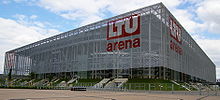 The Esprit Arena (former LTU)
The Esprit Arena (former LTU)
Düsseldorf's football team Fortuna Düsseldorf, the German Champions of 1933, German Cup Winners of 1979, 1980 and European Cup Winners Cup finalists of 1979 competes in the second German league (2. Bundesliga). Their new stadium, the Esprit arena, opened in January 2005 and has a capacity of 54,500. Düsseldorf is one of nine 1974 FIFA World Cup cities and the Rochusclub Düsseldorf has hosted the tennis world team cup since 1978.
Other sports in Düsseldorf are ice hockey (the DEG Metro Stars, former DEG - Düsseldorfer Eislauf Gemeinschaft, which play in the new ISS-Dome) and American football. The Düsseldorf Panther are the most successful team in Germany with six national champion trophies and the Eurobowl 1995. In addition the Junior-Programm is the most successful youth-football program in Germany with thirteen national championship titles. Rhine Fire Düsseldorf was an established team of the NFL Europe and won the World Bowl two times in 1998 and 2000. Düsseldorf has a successful rugby union team (Düsseldorf Dragons), who play in the regional NRW league and consistently finish with a top 3 position. Table tennis is also played (Borussia Düsseldorf - the most successful team in Germany with Timo Boll), as are handball (HSG Düsseldorf), basketball (Düsseldorf Giants), baseball (Düsseldorf Senators) and dancing (Rot-Weiß Düsseldorf).
Education
Heinrich Heine University Düsseldorf is located in the southern part of the city. It has about 20,000 students and a wide range of subjects in natural sciences, mathematics, computer sciences, philosophy, social sciences, arts, languages, medicine, pharmacy, economy and the law.
Other academic institutions include
- the Clara Schumann Musikschule (music school)
- the Robert Schumann Hochschule
- the Kunstakademie Düsseldorf (Official Homepage) (Academy of Fine Arts) which is famous for high-profile artists like Joseph Beuys, Paul Klee, Nam June Paik, Gerhard Richter, the Bechers, and Andreas Gursky.
- the Fachhochschule Düsseldorf (official website) (University of Applied Sciences).
- the AMD Academy of Fashion and Design (official website)
- the Max Planck Institute for Iron Research (Official homepage of the institute)
- The Goethe Institute (Official Homepage)
- Verwaltungs- und Wirtschafts-Akademie Düsseldorf
Notable buildings
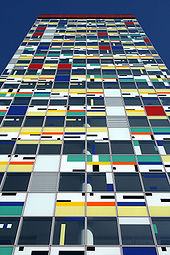 The Colorium at Düsseldorf Media Harbour by architect Will Alsop
The Colorium at Düsseldorf Media Harbour by architect Will Alsop
- Rheinturm (TV tower) the city's landmark (1982: 234 m/768 ft, since 2004: 240.50 m/789 ft), the lights on which comprise the world's largest digital clock.
- The Gehry buildings in the Düsseldorf media harbour (see picture above).
- The Colorium, an 18 storey tower designed by Alsop and Partners, also in the Düsseldorf media harbour.
- The Benrather Schloss (Benrath palace).
- The Wilhem Marx House of 1922/24: at twelve storeys high, it was Germany's first high-rise building.
- The Stahlhof of 1906, the administrative centre of Germany's steel economy until 1945.
- The Stummhaus of 1925, another early German high-rise building.
- Gerresheim Basilica.[36]
- St. Suitbertus Basilica.[37]
- DRV Tower, 120 m (394 ft)-high tower constructed in 1978.
- GAP 15, an 85 m (279 ft)-high building constructed in 2005 near Königsallee.
- ARAG-Tower, at 131 m (430 ft) in height, it is Düsseldorf's highest office building; designed by Sir Norman Foster.
- Eight bridges span the River Rhine at Düsseldorf; they, too, are city landmarks.
- Eastern pylon of Reisholz Rhine Powerline Crossing, an electricity pylon under whose legs runs a rail
Notable places
- Kö (Königsallee), a shopping street with luxuries shops
- Schloss Benrath, rococo castle
- Altstadt (Düsseldorf), the old town
- Düsseldorf-Hafen, the harbour is a modern build district
- Kaiserswerth, historical district with the ruined castle of Barbarossa Frederick I, Holy Roman Emperor
- Hofgarten, old city park
Twin towns – Sister cities
Düsseldorf is twinned with:[38]
 Reading, United Kingdom, since 1947, officially since 1988[38]
Reading, United Kingdom, since 1947, officially since 1988[38] Haifa, Israel [38][39]
Haifa, Israel [38][39] Chemnitz, Saxony, Germany [38]
Chemnitz, Saxony, Germany [38] Toulouse, France
Toulouse, France Warsaw, Poland [38]
Warsaw, Poland [38] Moscow, Russia [38]
Moscow, Russia [38] Chongqing, China [38]
Chongqing, China [38]
See also
References
- ^ "Amtliche Bevölkerungszahlen" (in German). Landesbetrieb Information und Technik NRW. 31 December 2010. http://www.it.nrw.de/statistik/a/daten/amtlichebevoelkerungszahlen/index.html.
- ^ "Communla Administration of Düsseldorf, 28 of July 2008." (PDF). http://www.duesseldorf.de/presse/pld/d2008/d2008_07/d2008_07_28/08072813_160.pdf. Retrieved 2010-04-16.
- ^ "Immobilien Zeitung: ''Mehr Räume für die große Modenschau'' vom 28. August 2008, 1st of March 2009." (PDF). http://www.anteon.de/images/stories/Anteon/Pressearchiv/IZ_280808.pdf. Retrieved 2010-04-16.
- ^ "'Cushman & Wakefield - European Cities Monitor'". http://www.europeancitiesmonitor.eu/wp-content/uploads/2010/10/ECM-2010-Full-Version.pdf. Retrieved 2011-06-04.
- ^ "'Messe Düsseldorf Annual Report'". http://www.messe-duesseldorf.com/md-files/doc/MD_annual_report_2009.pdf. Retrieved 2011-06-04.
- ^ 2010 survey by Jones Lang LaSalle (German)
- ^ 1,525,029 inhabitants for the Düsseldorf Larger Urban Zone
- ^ "Mercer's 2009 Quality of Living survey highlights - Global". Mercer. 2009-04-28. http://www.mercer.com/summary.htm?idContent=1128060. Retrieved 2009-07-07.
- ^ Woolsey, Matt (2009-04-28). "World's 20 Best Places To Live". Forbes.com. http://www.forbes.com/2009/04/27/cities-best-live-lifestyle-real-estate-best-places-to-live.html.
- ^ Bezirksregierung Düsseldorf - Luftreinhalteplan (2004)PDF
- ^ Klimaatlas - NRW (1989): Der Minister für Umwelt, Raumordnung und Landwirtschaft des Landes Nordrhein-Westfalens, Düsseldorf.
- ^ "Weather Information for Düsseldorf". http://www.weather.com/outlook/travel/businesstraveler/wxclimatology/monthly/GMXX0028.
- ^ Weidenhaupt, Hugo: Kleine Geschichte der Stadt Düsseldorf, Triltsch-Verlag, Düsseldorf 1979, ISBN 3-7998-0000-X, (only in German)
- ^ a b http://de.wikipedia.org/wiki/Düsseldorfer_Radschläger
- ^ The German Revolution 1917-1923, by Pierre Broué, Ian H. Birchall, Brian Pearce, p278
- ^ Stanton, Shelby, World War II Order of Battle: An Encyclopedic Reference to U.S. Army Ground Forces from Battalion through Division, 1939-1946 (Revised Edition, 2006), Stackpole Books, p. 174.
- ^ "Statistisches Bundesamt Deutschland - Neue Daten zur Migration in Deutschland verfügbar". Destatis.de. 2008-10-20. http://www.destatis.de/jetspeed/portal/cms/Sites/destatis/Internet/DE/Presse/pm/2007/05/PD07__183__12521,templateId=renderPrint.psml. Retrieved 2011-04-08.
- ^ "Landeshauptstadt Düsseldorf - Bevölkerung nach Nationalität". Duesseldorf.de. 2009-12-31. http://www.duesseldorf.de/statistik/stadtforschung/download/gesamtstadt.pdf. Retrieved 2010-12-29.
- ^ a b "Japanese Düsseldorf - Düsseldorf Travel Guide - VirtualTourist.com". VirtualTourist.com. 2003-02-11. http://www.virtualtourist.com/travel/Europe/Germany/Land_Nordrhein_Westfalen/Duesseldorf-67466/Local_Customs-Duesseldorf-Japanese_Duesseldorf-BR-1.html. Retrieved 2009-05-05.
- ^ a b "Japantag in Düsseldorf: Welcome". Japantag-duesseldorf-nrw.de. http://www.japantag-duesseldorf-nrw.de/305.html?&L=1. Retrieved 2009-05-05.
- ^ http://www.duesseldorf.de/de/
- ^ "Landeshauptstadt Düsseldorf - Aus den Stadtteilen". Duesseldorf.de. http://www.duesseldorf.de/bv/index.shtml. Retrieved 2009-05-05.
- ^ "Kontakt." LTU International. Retrieved on 21 June 2009.
- ^ http://web.archive.org/web/20070809144413/http://comfort-gmbh.de/pressemitteilungen/21.03.2007.pdfPDF (91.4 KB)
- ^ studio orange. "Altbier". Brauer-bund.de. Archived from the original on 2007-04-29. http://web.archive.org/web/20070429113232/http://www.brauer-bund.de/bierfans/sorten/alt.htm. Retrieved 2009-05-05.
- ^ "Michael Jackson's Beer Hunter - Copper-bottom ales halt lager tide in Germany". Beerhunter.com. http://www.beerhunter.com/documents/19133-000838.html. Retrieved 2009-07-08.
- ^ "Altbier". Germanbeerinstitute.com. http://www.germanbeerinstitute.com/altbier.html. Retrieved 2009-07-08.
- ^ "Düsseldorf Breweries". Europeanbeerguide.net. http://www.europeanbeerguide.net/dussbrew.htm#schumacher. Retrieved 2009-07-08.
- ^ Prost! The Story of German Beer, Horst D. Dornbusch, Brewers Publications, 1997, pp 109 - 110. ISBN 0937381551
- ^ "Düsseldorf Pub Guide: the best beer bars, pubs and brewpubs". Europeanbeerguide.net. http://www.europeanbeerguide.net/dusspubs.htm. Retrieved 2009-07-08.
- ^ Horst Dornbusch, Altbier. Boulder, CO: Brewers Publications
- ^ Fuchschen web page on Weihnachtsbier, visited 2007.04.26
- ^ The Guardian, 2003-07-24, accessed 2010-10-31, Desperately seeking Kraftwerk, "Kraftwerk were so far ahead of their time that the rest of the world has spent 25 years inventing new musical genres in an attempt to catch up. Another famouse Synth-pop band to come from the city was Propaganda. House, techno, hip-hop, trip-hop, synthpop, trance, electroclash: Kraftwerk's influence looms over all of them. It's difficult to imagine what rock and pop music would sound like today if Kraftwerk had never existed"
- ^ "Düsseldorf Altstadt: Van Gogh, Stilleben mit ABB-Senf". Duesseldorf-altstadt.blogspot.com. 2007-01-25. http://duesseldorf-altstadt.blogspot.com/2007/01/van-gogh-stilleben-mit-abb-senf.html. Retrieved 2009-05-05.
- ^ a b c d e "Giving beer a home in the Rhineland". The Local. 28 July 2011. http://www.thelocal.de/society/20110728-36597.html. Retrieved 28 July 2011.
- ^ "Gerresheim Basilica". http://www.duesselgruft.de/Duesseldorf/Gerresheim/P1070_1.jpg. Retrieved 2011-06-01.
- ^ "St. Suitbertus Basilica". http://www.duesseldorf.de/denkmalschutz/grafik/m32.jpg. Retrieved 2011-06-01.
- ^ a b c d e f g "Twin Towns". www.amazingdusseldorf.com. http://www.amazingdusseldorf.com/community-local/people/twin-towns.html. Retrieved 2009-10-29.
- ^ "Twin City acitivities". Haifa Municipality. Archived from the original on 2007-10-09. http://web.archive.org/web/20071009084809/http://www.haifa.muni.il/Cultures/en-US/city/CitySecretary_ForeignAffairs/EngActs.htm. Retrieved 2008-02-14.
External links
- Wikidus.de The Wiki for Düsseldorf
- Düsseldorf Official English website of the city
- visitduesseldorf.de Official Düsseldorf Tourist Board
- Düsseldorf City Panoramas
- Burrying the Hoppeditz: Carnival in Düsseldorf
- The Lost City WW2 Bomb Damage 1942/3

Krefeld Duisburg, Essen Dortmund 
Mönchengladbach 
Wuppertal, Kassel  Düsseldorf
Düsseldorf 

Aachen Leverkusen, Bergisch Gladbach, Cologne, Bonn Siegen Categories:- Cities in North Rhine-Westphalia
- Düsseldorf
- German state capitals
- Populated places on the Rhine
- Turkish communities in Germany
Wikimedia Foundation. 2010.

